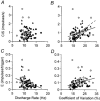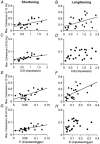Motor unit synchronisation is enhanced during slow lengthening contractions of a hand muscle
- PMID: 12456843
- PMCID: PMC2290686
- DOI: 10.1113/jphysiol.2002.026948
Motor unit synchronisation is enhanced during slow lengthening contractions of a hand muscle
Abstract
This study examined the strength of motor unit synchronisation based on time- and frequency-domain measures during postural, shortening and lengthening contractions of a hand muscle in young adults. Single motor unit activity was recorded with intramuscular electrodes in the left first dorsal interosseus muscle as the subject held the index finger at a constant position while supporting a light load for 2-5 min. The subject then performed slow (1.7 deg s(-1)) shortening and lengthening contractions to lift and lower the load. The movement required subjects to perform 10-25 constant-velocity contractions with the index finger over a 10 deg range of motion by using 6 s shortening and lengthening contractions. Individual discharge times were obtained from 23 pairs of motor units in 14 subjects to assess the strength of motor unit synchronisation and coherence during the three tasks. The strength of motor unit synchronisation was approximately 50 % greater during the lengthening contractions compared with the postural and shortening contractions, and the width of the central synchronous peak in the cross-correlation histogram was approximately 4 ms narrower during shortening contractions. These findings reveal that there is an increase in common input to motoneurones during lengthening contractions and a greater relative contribution of direct common inputs to motoneurones during shortening contractions compared with postural tasks. Furthermore, the amount of motor unit coherence in the low-frequency band (2-12 Hz) was reduced during shortening contractions compared with postural and lengthening contractions. These data indicate that the timing of inputs received by the motoneurones innervating the first dorsal interosseus of young adults differs during postural, shortening and lengthening contractions against a light load.
Figures







References
-
- Andres FG, Mima T, Schulman AE, Dichgans J, Hallett M, Gerloff C. Functional coupling of human cortical sensorimotor areas during bimanual skill acquisition. Brain. 1999;122:855–870. - PubMed
-
- Baker JR, Bremner FD, Cole JD, Stephens JA. Short-term synchronization of intrinsic hand muscle motor units in a ‘deafferented’ man. Journal of Physiology. 1988;396:155P. - PubMed
-
- Baker SN, Kilner JM, Pinches EM, Lemon RN. The role of synchrony and oscillations in the motor output. Experimental Brain Research. 1999;128:109–117. - PubMed
-
- Brown P. Muscle sound during human wrist movements. Journal of Physiology. 1996;494P:68P.
Publication types
MeSH terms
Grants and funding
LinkOut - more resources
Full Text Sources

